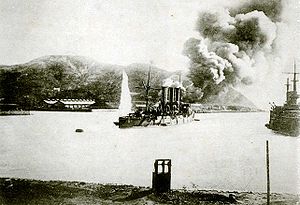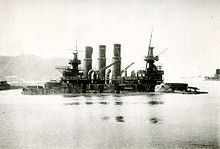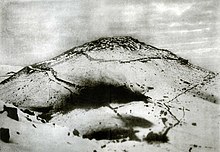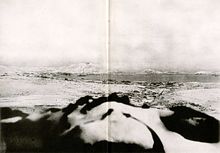Siege of Port Arthur
| date | August 1, 1904 to January 2, 1905 |
|---|---|
| place |
Port Arthur on the southern tip of the Liaodong Peninsula |
| output | Strategic Japanese victory |
| Parties to the conflict | |
|---|---|
| Commander | |
| Troop strength | |
| 50,000 soldiers, 14,000 seamen of the 1st Pacific Squadron 506 guns |
90,000–150,000 soldiers, 474 guns |
| losses | |
|
15,000 dead, wounded and prisoners |
94,000–110,000 dead, wounded and missing |
Port Arthur (Sea Battle) - Chemulpo - Yalu - Nanshan - Te-li-ssu - Hitachi-Maru Incident - Motien Pass - Tashihchiao - Hsimucheng - Port Arthur (Siege) - Yellow Sea - Ulsan - Korsakov - Liaoyang - Shaho - Sandepu - Mukden - Tsushima - Sakhalin
The siege of Port Arthur ( Japanese 旅順 攻 囲 戦 ryojun kōisen ; Russian Оборона Порт-Артура ) lasted from July 19 jul. / August 1, 1904 greg. until December 20, 1904 jul. / January 2, 1905 greg. and was the longest and one of the most costly battles of the Russo-Japanese War . Port Arthur, actually Lüshunkou , located on the southern tip of the Chinese Liaodong peninsula , was the only ice-free deep - water port in Russia in the Far East, the base of the 1st Pacific Squadron and therefore of strategic importance for military operations by the Russian Pacific Fleet in the Yellow Sea .
From a military-historical point of view, the siege is considered to be a turning point in warfare, as it was the first time that weapons and tactics were used on a large scale that were to shape the military strategies of the first half of the 20th century. During the siege, machine guns and heavy siege guns were used in large numbers for the first time . The Japanese attacks on the heavily fortified Russian trenches and bunker positions led to a protracted and loss-making trench war .
During the siege, a 2nd Pacific Squadron was relocated from the Baltic Sea to relieve the fortress. Its journey around half the globe, however, dragged on for eight months and was delayed by the Dogger Bank incident , so that the Russian garrison surrendered on January 2, 1905. The loss of the port and thus one of the most important bases of operations of the Russians destroyed the plans to unite the 1st and 2nd Pacific Squadrons and is considered to be decisive for the defeat of Russia.
prehistory
The Russian garrison of almost 50,000 men was under the command of General Anatolij Michailowitsch Stößel (1848–1915). Admiral Makarov's 1st Pacific Squadron, consisting of 13 cruisers and battleships, was in the harbor .
The fortifications were built according to the plans of General Totleben . Most of the fortifications, however, were not fully developed at the beginning of the war due to a lack of resources. On February 16, 1904, over 5000 men were still busy with the work. 5 redoubts , 3 bezels , numerous batteries , several kilometers of trenches and other facilities were provided. The outer defensive ring consisted of a series of flat mounds including Hsiaokushan and Takushan to the east, and Namakoyama, Akasakayama, and 174 and 203 mounds to the west. These were heavily attached. About 1.5 km behind this first line of defense there was a strong wall that enclosed the old town of Lüshun. This line had been expanded further to the west by the Russians and also included the new town of Port Arthur.
On the night of February 8th to 9th, 1904, the Imperial Japanese Navy attacked the port of Port Arthur without prior declaration of war . The battleships Retwisan and Zessarewitsch and the cruiser Pallada were badly damaged. Since Admiral Tōgō Heihachirō attacked his torpedo boats in several waves, the Russians were able to repel all further attacks.
Tōgō's fleet blocked the entrance to the port and fought a number of smaller skirmishes with the Russian fleet. The Russians suffered a decisive setback when Admiral Makarov's flagship Petropavlovsk ran into a mine on April 13, 1904 and sank with most of the crew, including the Admiral. The command took over Admiral Withöft , who left the fleet mostly idle in the harbor, so that the Japanese could begin unhindered with the landing of the troops near the Korean city Incheon . Before that, they had forced the Russian cruiser Varyag and the gunboat Korejez to sink themselves after a battle that was hopeless for the Russians.
General Stößel withdrew completely to Port Arthur on July 30, 1904 after the 3rd Japanese Army had approached the city under the command of General Nogi Maresuke .
course
Battle of Takushan and Hsuaokushan Hills
From August 7 to August 19, 1904, the Japanese shot the Russian fortifications with land and ship guns ready to attack . Meanwhile, the Japanese army in the northeast prepared to attack the first, more distant hills Takushan and Hsuaokushan. Their fortifications were not so well developed, but the hills were enclosed by steep slopes and lay directly on the river Ta, which had been dammed by the Russians in order to present a stronger obstacle. After the preparatory bombing, General Nogi had his infantry attacked. Heavy rain and poor visibility hampered the Japanese advance and many Japanese drowned in the river. However, with heavy losses, the Japanese managed to take both hills on August 8th and 9th.
After the hill was lost, Tsar Nicholas II telegraphed Admiral Withöft and ordered an immediate attempt to break out of the fleet. On the morning of August 10, the squadron set sail and met the Tōgō fleet waiting for them. In the naval battle that followed in the Yellow Sea , Admiral Withoft fell, and most of the Russian fleet returned to the port, where the ships now remained inactive.
Battle of the Hill 174
After the Russians turned down an offer of surrender by the Japanese, another attack began on August 19, 1904. The main advance was aimed at Hill 174. This was carried out by the 5th and 13th East Siberian Regiments and sailors of the 1st Pacific Squadron under the command of the Colonel Tretyakov defends.
Due to a lack of fresh troops, the defenders had to withdraw on August 20 and leave the hill to the Japanese.
By then, Nogi's strategy of frontal attacks had increased Japanese casualties to 16,000 dead and wounded. Since the small area gains were disproportionate to the number of losses, Nogi changed his strategy and prepared for a longer siege.
The siege

General Nogi commissioned his sappers with the construction of a tunnel system under the Russian positions, which he wanted to collapse by means of targeted mine explosions . At the same time, he reinforced his troops by 16,000 men and requested further artillery support, mainly to make up for his high losses from the first battles.
28 cm howitzers , which were to fire over 16,949 projectiles at the Russian positions in the following months, brought a decisive advantage .
General Stößel meanwhile had to deal with unrest among his subordinates. In addition, there were first cases of scurvy and diarrhea among the teams due to poor care .
The Japanese General Kodama Gentarō drew Nogi's attention to the hill 203, also called High Mountain , from which one could overlook the entire port area. Kodama recognized the importance of the hill for the Russian defense and saw in it the key to the Japanese victory.
By mid-September the Japanese had driven a network of trenches up to the Russian positions. During the attack on September 19, 1904, they captured the city's waterworks. They conquered Namakoyama Hill that same day.
Battle of the high mountain (hill 203)
The Japanese attacks were increasingly concentrated on Hill 203, but the Russian defenders repulsed each attack with heavy losses on both sides. Gains in terrain of a few meters were usually immediately recaptured in the subsequent counter-attacks by the other side. After Nogi lost more than 3,500 men without making up ground, he decided to suspend the attacks for the time being.
This break was used by the Russians to further expand the positions on the hill. Meanwhile, Nogi continued the artillery bombardment of the city and the port.
On October 29, 1904, Nogi wanted to take the hill with another massive frontal attack in order to be able to present it to the Tennō , Emperor Meiji , on his birthday on November 3rd as a gift. After six days and an extremely bitter fight, however, Nogi was only able to report the deaths of 124 officers and 3,611 soldiers to Tokyo .
With the beginning of winter, Nogi received more guns, which in addition to the 450 already in position, continued the bombardment of the Russian positions. With the help of telephone lines , the Japanese were finally able to better coordinate their fire and control them from a central fire control center.
The news about the 2nd Russian Squadron, which was on its way to the Far East and was already in the Atlantic, increased the political pressure on Nogi, who now had to take the hill at all costs.
The Russians, under the command of Colonel Tretyakov, had meanwhile reinforced their fortifications on Hill 203. The defenses were largely intact despite the previous attacks. The steep slopes were also surrounded by barbed wire fences that were under current .
After two more setbacks, Nogi feared being removed from his command. Thanks to the intercession of the emperor, he was allowed to stay at his post, but was assigned General Kodama Gentarō, who further urged Nogi to finally take the hill.
The pioneers had pushed the tunnel systems even closer to the Russian positions, and on November 26, 1904, Nogi ordered another attack. The frontal attacks on the forts Erhlung and Sungshu were repulsed again by the Russians. The Japanese officially lost 4,000 men, but the losses may have been twice as many.
On the morning of November 28, 1904, the Japanese, accompanied by massive artillery support, began another attack on the Akasakayama and 203 hills. They reached the barbed wire barn in front of the Russian defense lines and were able to hold this position for the next day. Despite the massive artillery fire, the Russian defenders were able to inflict heavy losses on the Japanese through their machine gun fire and the use of hand grenades .
The battle continued in the following days with unchanged intensity and on December 5, 1904, the Japanese succeeded in conquering Hill 203. At the top of the hill they only found a handful of Russian survivors. The Russians immediately launched two counter attacks to retake the hill, but both failed. With that the hill was under the control of the Japanese. The capture of the hill had resulted in the loss of an additional 8,000 soldiers. Nogi's second son was among the dead. On the Russian side there were also 6,000 dead and wounded.
Destruction of the Russian Pacific Fleet
After Nogi had sent forward observers to height 203 , they were able to direct the fire of the 28 cm howitzers via telephone and thus systematically destroy the Russian fleet in the coming days. Some commanders anticipated the inevitable and sank their ships themselves.
The Poltava liner was sunk on December 5th and the Retwisan on December 7th . On December 9, 1904, Pobeda and Peresvet, as well as the cruisers Pallada and Bajan , sank . The ship of the line Sevastopol was able to be maneuvered out of the firing range of the Japanese, although it had already been hit five times by heavy shells. Admiral Tōgō, who had received a corresponding order from Tokyo, did not want to let the Sevastopol escape under any circumstances and sent his torpedo boats into the harbor in several waves. In the following three weeks the Japanese fired more than 124 torpedoes at the ship and lost two destroyers in turn . At the same time, the Japanese cruiser Takasago sank , which had run into a mine outside the port.
On the night of January 2, 1905, when the Russian garrison surrendered, Captain Nikolai von Essen sank the last ship of the line, the Sevastopol , even by one-sided flooding in the deeper part of the port, in order to rescue it through the wreckage and because of the lateral position of the wreck Prevent Japanese.
The surrender
After the loss of the fleet, Stößel discussed with his staff on December 8, 1904 whether further resistance would still be useful. The majority of the senior officers flatly refused to surrender . After the death of General Kondratenkos on 15 December 1904 Fort Chikuan replaced ram this through Lieutenant General Fok . On December 18, 1904, the Japanese detonated a 1,800 kilogram mine under Fort Chikuan, which fell that night. Fort Erhlung suffered the same fate on December 28th.
On December 31, 1904, a series of explosions shook the last remaining Russian position, Fort Sungshu, which had to be abandoned the same day. On January 1, 1905, Wantai finally fell into Japanese hands. On the same day Stößel and Fok asked General Nogi to start talks about surrender. Stößel had not consulted any of the other Russian officers. The declaration of surrender was signed on January 2, 1905.
The remaining Russian soldiers were taken prisoner of war . All civilians who were still in Port Arthur were given safe conduct. The Russian officers could also withdraw freely, provided they promised not to take part in the war any more. A total of 868 officers, 23,491 soldiers, 9,000 seamen of the destroyed squadron and 16,000 sick and wounded were taken prisoner of war. In addition, the Japanese captured 546 guns, 83,000 grenades and 3,000 kg of powder.
The Japanese later officially put their losses at 57,780 dead, wounded and missing.
Nogi left Port Arthur with the majority of his remaining 120,000 men to assist Field Marshal Oyama in the imminent Battle of Mukden .
Effects
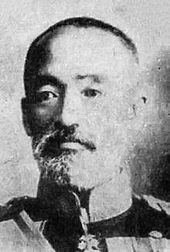

News of the Port Arthurs fall shocked the Russian population and demoralized the rest of the troops. The 2nd Pacific Squadron under Admiral Roschestwensky , which was off Madagascar at that time, was deprived of its planned base of operations . When attempting to break through to the remaining units in Vladivostok , the naval battle of Tsushima broke out on May 27 and 28 , in which the Russians suffered one last devastating defeat. This sealed the end of the war. Shortly afterwards, the tsar accepted an offer to mediate by US President Theodore Roosevelt . On September 5, 1905, the Portsmouth Peace Treaty was signed at the Portsmouth Naval Shipyard .
In the months that followed, the Japanese salvaged the majority of the ships sunk in the port, repaired them and put the ships back into service.
General Stößel and his subordinate officers Foch and Smirnow were charged with cowardice before the enemy on their return to Russia. Stößel was sentenced to death by shooting on February 7, 1908. The sentence was later commuted to a ten-year prison term. After almost a year in prison, he was released on May 6, 1909. Stößel died in January 1915.
General Nogi, who had lost his two sons in battle and felt responsible for the deaths of thousands of his subordinate soldiers, asked the Tennō for permission to commit seppuku . Emperor Meiji refused to do so. After Meiji's death, Nogi and his wife Shizuko committed Seppuku on September 13, 1912. Both are venerated as kami in the nogi shrines dedicated to them .
The siege, observed by numerous war correspondents, brought various insights into the field of military affairs . The massive use of modern machine guns and heavy siege artillery had proven extremely effective. On the other hand, the relatively long duration of the siege strengthened the certainty of some fortress builders that their structures would withstand until a military decision was reached elsewhere. However, this approach did not prove to be absolutely correct during the First World War : on the one hand, the forts of the fortress ring around Liège were forced to surrender within a few days with heavy siege artillery (including the " Big Bertha ") (→ Conquest of Liège (1914) ), on the other hand it was proven The French fortress Verdun turned out to be an insurmountable obstacle for the German invaders. The great importance of pioneering was also increasingly recognized , as the fall of the fortress was to a large extent a success of the Japanese sappers and miners .
Coordinates: 38 ° 47 '47 " N , 121 ° 14' 10" E
literature
- Richard Connaughton: Rising sun and tumbling bear. Russia's war with Japan. Cassell, London 2003, ISBN 0-304-36184-4 .
- First edition: Richard Michael Connaughton: The War of the Rising Sun and the Tumbling Bear. A military history of the Russo-Japanese War 1904 - 5. Routledge, London a. a. 1988, ISBN 0-415-00906-5 .
- Constantine Pleshakov : The Tsar's last armada - The epic voyage to the battle of Tsushima. Basic Books, New York NY 2002, ISBN 0-465-05792-6 .
- Gottlob Egelhaaf: Recent history from the Peace of Frankfurt to the present . Carl Krabbe Verlag, Stuttgart 1913.
Movie
- Port Arthur - The battle of the decision (original title: 203 kôchi ). Feature film, Japan, 1980. Director: Ihiji Maruyama.
- The battle was themed in 2011 in episode 11 of the Japanese television series Saka no Ue no Kumo .
Web links
- The Russo-Japanese War Research Society (English)
- Graham J. Morris: The Siege of Port Arthur (English)
- Timeline for the Russo-Japanese War 1904–1905 ( Memento from May 29, 2009 in the Internet Archive )
- Colonial Warfare 1880–1975, with a map showing the hill 203 (English)
Individual evidence
- ↑ Оборона Порт-Артура. А. фон-Шварц, Ю. Romansky. 1908
- ^ Port Arthur, the siege and capitulation, Volume 1, Ellis Ashmead-Bartlett, 1906, p.464
- ↑ Сорокин А. И. Оборона Порт-Артура. Русско-японская война 1904–1905
- ↑ The Defender of Port-Arthur and His Followers. In: Neue Freie Presse , Morgenblatt, No. 14498/1905, January 3, 1905, p. 5, top right. (Online at ANNO ). as well as plunger . In: Brockhaus' Kleines Konversations-Lexikon . Fifth edition, volume 2. Leipzig 1911, p. 773.
- ^ Toepfer: The fastening of the Kintschouststellung , in Kriegstechnische Zeitschrift, Mittler & Sohn, Berlin, 1907, pages 127-137. ( online at archive.org )
- ^ Website about History of Imperial Japanese Artillery
- ↑ History of the Modern Era from the Peace of Frankfurt to the Present , p. 482
